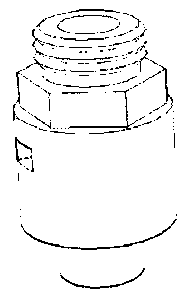Some of the information on this Web page has been provided by external sources. The Government of Canada is not responsible for the accuracy, reliability or currency of the information supplied by external sources. Users wishing to rely upon this information should consult directly with the source of the information. Content provided by external sources is not subject to official languages, privacy and accessibility requirements.
Any discrepancies in the text and image of the Claims and Abstract are due to differing posting times. Text of the Claims and Abstract are posted:
| (12) Patent Application: | (11) CA 2596313 |
|---|---|
| (54) English Title: | PRESSURE VALVE |
| (54) French Title: | SOUPAPE DE SECURITE |
| Status: | Deemed Abandoned and Beyond the Period of Reinstatement - Pending Response to Notice of Disregarded Communication |
| (51) International Patent Classification (IPC): |
|
|---|---|
| (72) Inventors : |
|
| (73) Owners : |
|
| (71) Applicants : |
|
| (74) Agent: | |
| (74) Associate agent: | |
| (45) Issued: | |
| (22) Filed Date: | 2007-07-31 |
| (41) Open to Public Inspection: | 2009-01-31 |
| Examination requested: | 2007-07-31 |
| Availability of licence: | N/A |
| Dedicated to the Public: | N/A |
| (25) Language of filing: | English |
| Patent Cooperation Treaty (PCT): | No |
|---|
| (30) Application Priority Data: | None |
|---|
The Pressure Valve can control the passage that the source pass through. The
effective area of the measuring element is smaller before the valve opens,
and the effective area of the measuring element is larger when the valve
opens. Higher source pressure is needed to open the valve and lower source
pressure is needed to keep it open. The magnetic force between the magnet
and the diaphragm attracts the diaphragm toward the magnet, the force is
much stronger when the diaphragm contacts the magnet. With the help of
magnetic force, the source pressure needs to go down more to make the
spring force to overcome the magnetic force and source pressure, the valve
close at lower source pressure. It provides a method to prevent fluid from
flowing from target end to the source end when the source pressure goes
down to certain level. The Pressure Valve is designed for expansion tank of
a boiler system. With the Pressure Valve, an expansion tank can be
pre--presurized with vapor, and will have more capacity.
Note: Claims are shown in the official language in which they were submitted.
Note: Descriptions are shown in the official language in which they were submitted.

2024-08-01:As part of the Next Generation Patents (NGP) transition, the Canadian Patents Database (CPD) now contains a more detailed Event History, which replicates the Event Log of our new back-office solution.
Please note that "Inactive:" events refers to events no longer in use in our new back-office solution.
For a clearer understanding of the status of the application/patent presented on this page, the site Disclaimer , as well as the definitions for Patent , Event History , Maintenance Fee and Payment History should be consulted.
| Description | Date |
|---|---|
| Inactive: Dead - No reply to Office letter | 2010-01-18 |
| Application Not Reinstated by Deadline | 2010-01-18 |
| Deemed Abandoned - Failure to Respond to Maintenance Fee Notice | 2009-07-31 |
| Application Published (Open to Public Inspection) | 2009-01-31 |
| Inactive: Cover page published | 2009-01-30 |
| Inactive: Abandoned - No reply to Office letter | 2009-01-19 |
| Inactive: Correction to amendment | 2008-10-17 |
| Amendment Received - Voluntary Amendment | 2008-08-12 |
| Inactive: Office letter | 2008-07-23 |
| Amendment Received - Voluntary Amendment | 2008-05-22 |
| Inactive: S.30(2) Rules - Examiner requisition | 2008-04-08 |
| Inactive: First IPC assigned | 2008-01-18 |
| Inactive: IPC assigned | 2008-01-18 |
| Inactive: IPC assigned | 2008-01-18 |
| Inactive: IPC assigned | 2007-12-21 |
| Inactive: First IPC assigned | 2007-12-21 |
| Amendment Received - Voluntary Amendment | 2007-11-14 |
| Inactive: Office letter | 2007-09-07 |
| Application Received - Regular National | 2007-09-05 |
| Letter Sent | 2007-09-05 |
| Inactive: Filing certificate - RFE (English) | 2007-09-05 |
| All Requirements for Examination Determined Compliant | 2007-07-31 |
| Request for Examination Requirements Determined Compliant | 2007-07-31 |
| Small Entity Declaration Determined Compliant | 2007-07-31 |
| Abandonment Date | Reason | Reinstatement Date |
|---|---|---|
| 2009-07-31 |
| Fee Type | Anniversary Year | Due Date | Paid Date |
|---|---|---|---|
| Application fee - small | 2007-07-31 | ||
| Request for examination - small | 2007-07-31 |
Note: Records showing the ownership history in alphabetical order.
| Current Owners on Record |
|---|
| JIANMING YANG |
| Past Owners on Record |
|---|
| None |